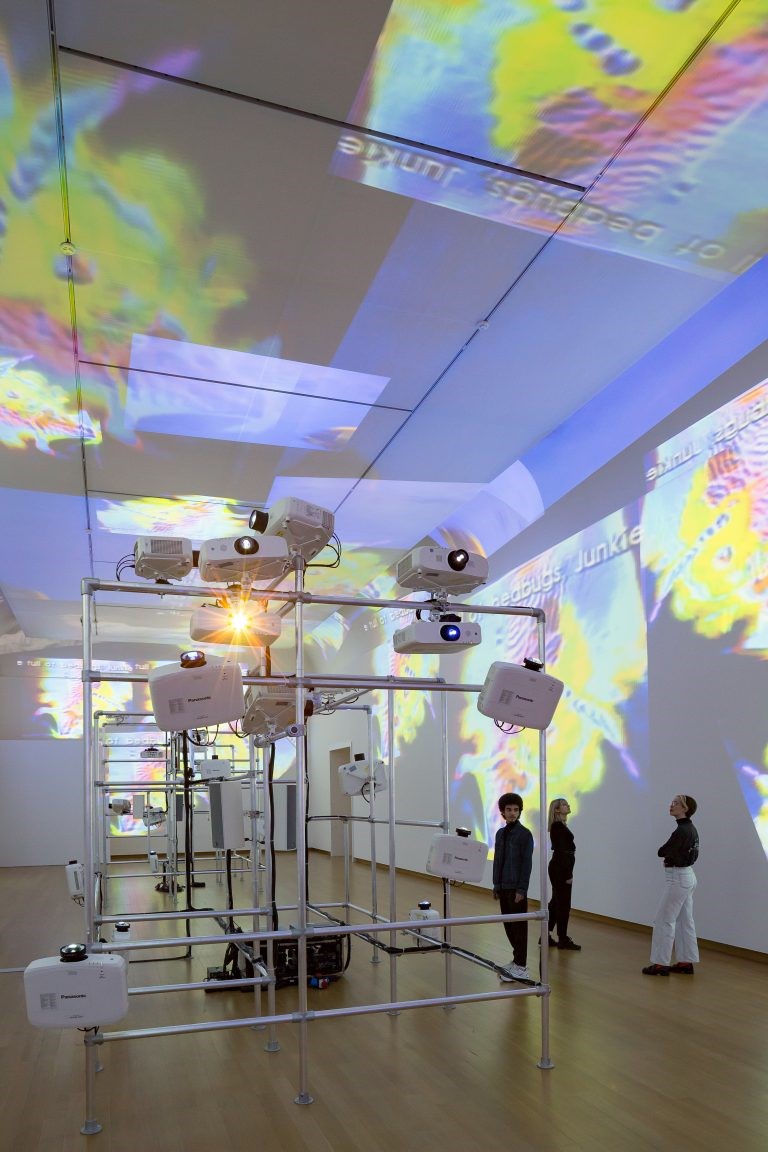Museums in European countries are finally allowed to reopen, albeit with new safety measures in place. Like so many museums around the world, the Stedelijk Museum in Amsterdam has extended its exhibitions to include the summer months. This years’ blockbuster show is called “Nam June Paik: The Future is Now” (on view until the 23rd of August), a large retrospective of Paik’s work from five decades of artistic enterprise. Its highlight is Sistine Chapel (1993), a large-scale video installation which has been projected on the ceiling and walls of one of the Stedelijk’s galleries. It is a collage of new footage and samples of past videos, thereby effectively providing a summary of Paik’s artistic career and of the previous galleries in the exhibitions. Paik originally created it for the German Pavilion at the Venice Biennale of 1993, and it earned him a Golden Lion. The name of the installation is a reference to the famously supercharged frescoes of the Vatican’s Sistine Chapel, painted in the fifteenth and sixteenth centuries by artists such as Michelangelo, Perugino and Botticelli. It is easy to see what they have in common: both ‘chapels’ are immersive experiences of lights, sounds and images.
It reminded me of another large project. 2018 was declared the year of Baroque in Antwerp and celebrated the continuing influence of Baroque art and the city’s most famous painter, Peter Paul Rubens (1577-1640). Among the many exhibitions and events worth attending, Athos Burez’ Baroque Burez at the Boulevard of Museum Aan de Stroom (MAS) was a particular must. Baroque Burez was an exhibition of eighty photographs and some large installations, covering the elevators and the walls of the different platforms of all ten levels of the museum. It was best experienced by travelling up the escalator and stopping on every level, whereby the visitor effectively circled around the building, which is set up like a tower. Athos Burez (1987) is a photographer from Ghent, and this was his first solo exhibition in Antwerp.
Though Burez was not inspired by the same period as Paik – Baroque art flourished in the seventeenth century – its visual language was derived from the same Mannerist style Michelangelo popularised in his frescoes. In fact, Burez’ visual ‘borrowing’ went much further, as he sought to translate Baroque style to a modern medium and for a modern audience. His photographs and installations, conveying Baroque-era-themes of opulence, decadence, and fragility quoted and interpreted familiar elements such as nudes, lush fabrics, and exotic flowers and fruits. However, Burez added contemporary elements such as selfies and beer bottles to create slightly absurd images. His work frequently mixes familiar and unfamiliar, contemporary and historic, in an ode to the suppressed side of society. Some of these beautifully lighted photographs are ethereal, a celebration of youth and fleeting beauty, while others are visions of times gone by. The classical warning of vanitas, that beauty fades and you must be sure to take care of your immortal soul, seems as relevant today as it was in the seventeenth century. More importantly, Burez calls the viewer’s attention to the Baroque that can be found in modern times and reminds the Antwerp visitor that this city is still very much writing its own history.
The contrast between these artists is perhaps not their differing mediums (photography and video collage) but their use of a connection to the past. Where Paik merely references the Renaissance, Burez reinterprets the Baroque-era. Sistine Chapel invites the viewer to draw a comparison between Paik’s work and the famous room. Perhaps it even hope to draw on its prestige. Baroque Burez demonstrates that the ‘Baroque’ can be found in contemporary life – though not quite in everyday settings – and that its visual language can still produce new ideas, despite the fact that the seventeenth century brought forth such a volume of art. In both works, the layering of images and impressions suggest human connection and vitality. And this may be the enduring legacy of the sixteenth and seventeenth centuries: that they provide a frame of reference particularly suited to the celebration of life.
“Baroque Burez,” MAS Antwerp 01.06.18 – 21.04.19 https://www.mas.be/en/activity/baroque-burez
“Nam June Paik: The Future is Now,” Stedelijk Museum Amsterdam 14.03.20 – 23.08.20 https://www.stedelijk.nl/en/exhibitions/nam-june-paik

Athos Burez, Baroque Burez, 2018, Photo credit: Nono C 
Athos Burez, Baroque Burez, 2018, Photo credit : Nono C 
Nam June Paik, Sistine Chapel, 1993, exhibition copy in the Stedelijk Museum thanks to the Nam June Paik Estate. Foto Peter Tijhuis